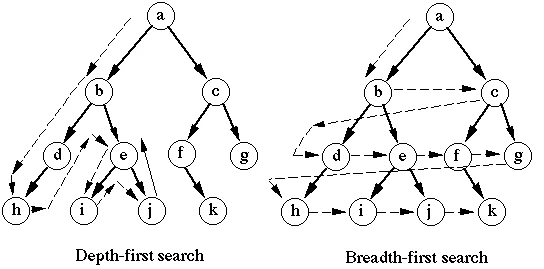Introduction
In the realm of computer science and algorithmic problem-solving, two fundamental techniques stand out: Breadth-First Search (BFS) and Depth-First Search (DFS).
These algorithms, while sharing the goal of traversing graphs or trees, employ distinct methodologies to achieve their objectives.
Understanding the Difference between BFS and DFS is crucial for programmers and computer scientists alike, as it influences their approach to problem-solving and algorithm design.
Understanding Breadth-First Search (BFS)
Breadth-First Search (BFS) is a graph traversal algorithm that explores all the neighbor nodes at the present depth before moving on to the nodes at the next depth level.
It starts at a designated source node and explores all of the neighbor nodes at the present depth prior to moving on to the nodes at the next depth level.
This strategy ensures that BFS traverses the graph or tree level by level, gradually expanding outward from the starting point.
Unveiling Depth-First Search (DFS)
Depth-First Search (DFS), on the other hand, is a graph traversal algorithm that explores as far as possible along each branch before backtracking.
Unlike BFS, which prioritizes breadth, DFS delves deeply into the structure, exploring as far as possible along each branch before backtracking.
This recursive nature of DFS lends itself well to certain problem-solving scenarios, particularly those involving traversal or search operations in deeply nested structures.
Analyzing the Difference between BFS and DFS
Memory Consumption
BFS typically consumes more memory compared to DFS. This heightened memory requirement stems from the need to maintain a queue data structure to facilitate level-by-level traversal.
In contrast, DFS tends to have a lower memory footprint since it can often operate with a stack data structure, which efficiently manages the recursive traversal process.
Performance in Dense Graphs
In dense graphs where the number of edges is close to the maximum possible for the number of vertices, DFS may outperform BFS.
This is because DFS can traverse deeply into the graph without needing to manage an extensive queue of neighboring nodes, as is the case with BFS.
Suitable Applications
While both algorithms have their strengths and weaknesses, they find distinct applications in various problem domains.
BFS is well-suited for scenarios requiring the shortest path finding, such as GPS navigation systems and network routing protocols.
Conversely, DFS shines in tasks involving cycle detection, topological sorting, and maze generation algorithms.
Complexity Analysis
The time complexity of BFS and DFS varies depending on the implementation and the characteristics of the graph being traversed.
In general, BFS has a time complexity of O(V + E), where V is the number of vertices and E is the number of edges.
On the other hand, DFS typically has a time complexity of O(V + E) as well, though it may vary depending on the specific problem and implementation details.
Handling Disconnected Graphs
Both BFS and DFS can handle disconnected graphs, albeit with differing approaches. BFS may require multiple iterations or additional data structures to ensure all nodes are visited, whereas DFS can navigate disconnected components more seamlessly due to its recursive nature.
Adaptability to Search Problems
The choice between BFS and DFS often hinges on the nature of the problem at hand.
BFS excels in scenarios requiring the shortest path or breadth-first traversal, offering a systematic approach to exploring the graph.
Conversely, DFS is favored in tasks where deep traversal or backtracking is essential, such as maze solving or cycle detection.
Frequently Asked Questions (FAQs)
- Can BFS and DFS be combined to optimize certain algorithms?
- Yes, BFS and DFS can be combined in certain scenarios to leverage the strengths of both algorithms. For instance, BFS can be used to find the shortest path between two nodes, while DFS can assist in additional traversal operations within specific branches of the graph.
- Are BFS and DFS deterministic algorithms?
- Yes, both BFS and DFS are deterministic algorithms, meaning that given the same input and initial conditions, they will produce the same output or traversal path every time they are executed.
- How do BFS and DFS handle graphs with cycles?
- BFS and DFS handle graphs with cycles differently. BFS may encounter difficulties in traversing cyclic graphs efficiently, especially if the algorithm does not incorporate cycle detection mechanisms. In contrast, DFS can navigate cyclic graphs adeptly, making it suitable for tasks such as cycle detection and topological sorting.
- Can BFS and DFS algorithms be parallelized for improved performance?
- While BFS and DFS are inherently sequential algorithms, certain parallelization techniques can be applied to enhance their performance. Parallel BFS, for instance, involves partitioning the graph and executing BFS simultaneously on different partitions, thereby reducing traversal time.
- What are some real-world applications of BFS and DFS?
- BFS and DFS find numerous applications across various domains. BFS is commonly used in network routing algorithms, shortest path finding, and web crawling, while DFS is employed in tasks such as maze solving, cycle detection, and topological sorting.
- How do BFS and DFS handle weighted graphs differently?
- In weighted graphs, where each edge has an associated weight or cost, BFS and DFS exhibit distinct behaviors. BFS is well-suited for finding the shortest path in unweighted graphs, whereas DFS may require modifications or additional data structures to handle weighted edges efficiently.
VISIT ALSO : How Omega3 Helps: Unlocking the Secrets to a Healthier Life
Conclusion
Understanding the Difference between BFS and DFS is essential for any programmer or computer scientist navigating the vast landscape of algorithmic problem-solving.
While BFS prioritizes breadth and systematic traversal, DFS delves deeply into the structure, offering unique advantages in certain scenarios.
By grasping the nuances of these algorithms, one can harness their power to tackle a myriad of computational challenges with precision and efficiency.


